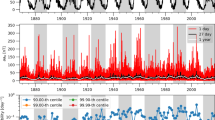Abstract
SMART-1 is a technology demonstration mission for deep space solar electrical propulsion and technologies for the future. SMART-1 is Europe’s first lunar mission and will contribute to developing an international program of lunar exploration. The spacecraft was launched on 27th September 2003, as an auxiliary passenger to GTO on Ariane 5, to reach the Moon after a 15-month cruise, with lunar capture on 15th November 2004, just a week before the International Lunar Conference in Udaipur. SMART-1 carries seven experiments, including three remote sensing instruments used during the mission’s nominal six months and one year extension in lunar science orbit. These instruments will contribute to key planetary scientific questions, related to theories of lunar origin and evolution, the global and local crustal composition, the search for cold traps at the lunar poles and the mapping of potential lunar resources
Similar content being viewed by others
References
Basilevsky A T, Keller H U, Nathues A, Mall U, Hiesinger H and Rosiek M 2004 Scientific objectives and selection of targets for the SMART-1 Infrared Spectrometer (SIR);Planet. Space Sci. 52 1261.
Clark P E and Adler I 1978 Utilization of independent solar flux measurements to eliminate non-geochemical variation in X-ray fluorescence data;Proc. Lunar Planet. Sci. Conf. 12 727–749.
Dunkin S K, Grande M, Casanova Iet al 2003 Scientific rationale for the D-CIXS X-ray spectrometer on board ESA’s SMART-1 mission to the Moon;Planet. Space Sci. 51 435–442.
Foing B H, Heather D, Almeida M and SMART-1 STWT 2001 The Science Goals of SMART-1;Earth, Moon, Planets 85–86 523–531.
Grande Met al 2002 The D-CIXS spectrometer and its capabilities for lunar science;Adv. Space Res. 30(8) 1901–1907.
Grande M, Browning R, Waltham Net al 2003 The D-CIXS X-ray mapping spectrometer on SMART-1;Planet. Space Sci. 51 427–433.
Josset J Let al 2005 The Advanced Moon Micro Imager Experiment (AMIE) on SMART-1: A miniaturized imag- ing system for the observation of planetary surfaces;Planet. Space Sci. submitted 2005.
Lawrence D J, Feldman W C, Elphic R C, Little R C, Prettyman T H, Maurice S, Lucey P G and Binder A B 2002 Iron abundances on the lunar surface as mea- sured by the Lunar Prospector gamma-ray and neu- tron spectrometers;J. Geophys. Res. 107(E12) 5130, 10.1029/2001JE001530.
Lucey P G, Taylor G J and Hawke B R 1998 FeO and TiO2 concentrations in the South Pole-Aitken basin: implications for mantle composition and basin formation;J. Geophys. Res. 103 3701–3708.
Marini A E, Racca G D and Foing B H 2002 SMART-1 Technology preparation to future planetary missions;Advances in Space Research 30(8) 1895–1900.
Muinonen K, Shkuratov Y, Ovcharenko Aet al 2002 The SMART-1 AMIE experiment: implication to the lunar opposition effect;Planet. Space Sci. 50(14–15) 1339–1344.
Pieters C M, Tompkins S, He Get al 1997 Mineralogy of the mafic anomaly in the South Pole-Aitken basin (SPA): implications for the excavation of the lunar mantle;Geophys. Res. Lett. 24 1903–1906.
Racca G D, Marini A, Stagnaro Let al 2002 SMART-1 Mis- sion Description and Development Status;Planet. Space Sci. 50 1323–1337.
Shearer C K and Papike J J 1999 Origin of the lunar mare high-titanium basalts: melting of a deep hybridized source or shallow assimilation of high-Ti Cumulates?;Lunar. Planet. Sci. Conf. 30 1365.
Shkuratov Y G, Stankevich D G, Kaydash V G, OmelchenkoV V, Pieters C M, Pinet P C, Chevrel S D, Daydou Y H, Foing B H, Sodnik Zet al 2003 Composition of the lunar surface as will be seen from SMART-1: A simulation using Clementine data;J. Geophys. Res. (Planets) 108(E4) 1.
Author information
Authors and Affiliations
Rights and permissions
About this article
Cite this article
Foing, B.H., Racca, G.D., Marini, A. et al. SMART-1 after lunar capture: First results and perspectives. J Earth Syst Sci 114, 689–697 (2005). https://doi.org/10.1007/BF02715952
Issue Date:
DOI: https://doi.org/10.1007/BF02715952




